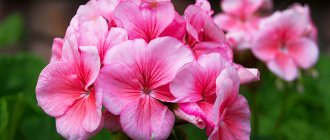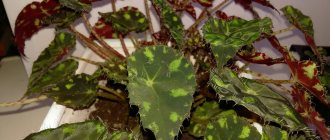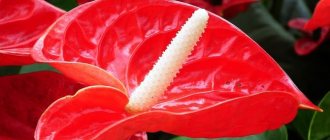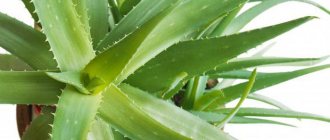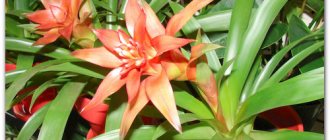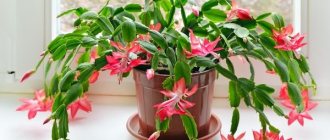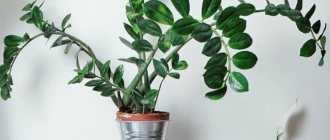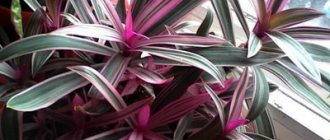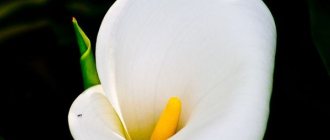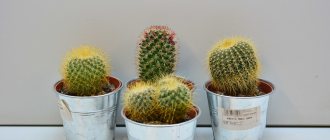Under the canopy of tropical forests in Central and South America you can see rosettes of lush green foliage, above which rise bright red, yellow and orange plumes - this is guzmania. Plants, named after A. Guzman, a famous traveler and naturalist from Spain, settle on fertile soil under the crowns of plants, lead the lifestyle of epiphytes, climbing roots and branches, and are found on open slopes.
Guzmanias, which are closely related to pineapples, belong to the Bromeliad family.
Plants differ among themselves in size, foliage color and lifestyle. Moreover, among the 120–130 species of these herbaceous evergreens, there are many varieties chosen by gardeners for keeping and growing indoors.
What are the features of the flower? What does Guzmania bring into the home, and what is it about it that attracts the attention of flower growers around the world?
What does the plant look like?
As is typical for epiphytes, the roots of this flower crop are not very strong. Under natural conditions, they serve as an attachment to the bark of a tree or rocky surface.
There is no stem as such. Narrow long green leaves are pressed tightly to the base, rising upward and forming a high rosette. The leaves of the peduncle at the top of the rosette are the usual scarlet color, however, hybrid varieties provide a wide choice of color combinations.
Different types and varieties of crops differ in the height, width and length of green leaves, the shape and color of the bract, as well as its height (from 40 to 70 cm).
Main problems
Growing any plant can present some difficulties. And even more so if we are talking about an exotic beauty who was forcibly transported to the European climate. The table will tell you what problems may arise and how to solve them.
Table - Guzmania diseases and flower treatment methods
| Problem | Cause | Treatment |
| Guzmania is not growing | — The soil has become poorer; — little fertilizer; - lack of light | — Apply fertilizers; — change location |
| Guzmania does not bloom | — Excess or deficiency of light; — low humidity; - malnutrition | — Change location; - provide proper feeding; - increase humidity |
| The lower leaves turn brown and dry out | - Water scarcity | — Provide humidity, but avoid waterlogging; - spray daily; - place the pot in a tray with wet peat |
| The leaves are drying | — Excessive watering; - stagnation of water in the outlet | — Reduce watering; - completely drain the water from the outlet |
| Leaves become sticky, deformed, covered with green insects | - There are aphids | - Spray with Pyrethrum; - treat with a systemic insecticide |
| The leaves turn yellow and dry, the plant becomes covered with a coating of soot and brown insects | — The scale insect started up | — Remove insects with soapy water; — treat with solutions “Karbofos”, “Aktellik”; - trim off severely affected leaves |
| The leaves dry out and cotton balls appear on the plant. | — Mealybug infestation | — Remove pests with a sponge soaked in soapy water; - cut off excessively affected areas with sharp scissors; - treat with Karbofos |
| Cobwebs appear on the plant, the leaves turn yellow and dry out. | — There are spider mites | — Increase humidity; - treat the leaves with insecticidal soap; - apply “Phosbecid” or “Decis”; - regularly ventilate the room |
| The flower turns pale | The natural process of dying of an old plant | |
The most vulnerable point of a plant is the root. Therefore, when caring for Guzmania in a pot, never over-moisten the soil. The rhizome can rot very quickly. But it is simply impossible to save the plant if the process of decay has begun.
Is it good or bad to keep a flower at home?
Guzmania was found in the tropics of America and immediately attracted attention with its charming appearance. For this reason, people started trying to grow it in their gardens and homes.
It is true that guzmania blooms only once in its entire life, but it is incredibly beautiful and long-lasting (up to 4 months). Now the choice of hybrid varieties is large: you can find specimens not only with scarlet, but also with orange, yellow, burgundy and pink rosettes.
INTERESTING! The tops of the rosettes are not actually inflorescences, but just modified foliage: its bright color is needed to attract the attention of pollinating insects.
Signs claim that the culture has disinfecting properties, which, without a doubt, will have a great effect on the quality of the surrounding air. The thing is that flowering is accompanied by the release of substances with bactericidal properties. Thus, culture will help you reduce the concentration of pathogenic microbes at home.
Signs and superstitions about Guzmania for men
According to the superstitions of the places where this plant comes from, it is considered the embodiment of male power. Therefore, it is believed that it helps to activate the vital forces of the male sex, promotes longevity and improves the condition of men in the physical and spiritual aspects.
According to signs, if a man is alone in the house, then Guzmania will definitely contribute to success on the personal front.
There is also such a superstition: if a man is already in a relationship, then they will become more passionate and begin to actively develop, bringing positive emotions.
Why does Guzmania bloom?
Guzmania typically blooms in autumn. If it begins to bloom at another time of the year, then according to signs and superstitions, this does not indicate the most pleasant things. Superstition says that unscheduled flowering is a symbol of a tense situation within the family. One of the reasons may be the spouses' passion for outside relationships.
According to signs, a flower that is healthy and blooms in autumn reflects the well-being of the family and home environment.
Signs also indicate that happy relationships, a friendly atmosphere and mutual understanding - all this has a beneficial effect on flowering.
Stimulation of flowering
The plant blooms in spring and summer. The first flowering occurs in the fourth year of life.
If the plant does not bloom for a longer period of time, flowering can be stimulated. To do this, the guzmania is closed with a plastic bag, in which 3-4 apples are placed and tied. Apples release ethylene into the air, which will stimulate flowering. The duration of stimulation is 10 days. The package should not be exposed to direct sunlight. It must be ventilated daily. Apples must be free of rotten spots.
The transplantation procedure is carried out when the plant is propagated. To do this, you need to choose a suitable pot and soil. Guzmania roots do not need a deep pot. They should be tightly placed in the container with the substrate. For greater stability, the container can be placed in a ceramic pot.
The substrate must be permeable, with an acidity of 5.5 to 7.0. Here is an example of one of the substrates acceptable for Guzmania:
Feng Shui meaning of Guzmania
The ancient Chinese wisdom of Feng Shui says that guzmania can greatly help those who shelter it in their home:
- Admiring the appearance will give you a feeling of calm and inner harmony;
- Guzmania will bring harmony to the couple’s intimate relationships and reveal their sensuality;
- In a duet with green plants it will promote development in the professional field;
- A specimen with yellow inflorescences will attract prosperity and fortune to the house.
REFERENCE! According to superstition, the energy of red or orange guzmania will be very appropriate in the Aries house: it will complement the owner and support his desires and aspirations.
Guzmania care
Beginning gardeners need to know a few basic needs of Guzmania.
Watering. Two to three times a week, especially if the room is cool. But you need to spray the leaves daily in the morning with water at room temperature.
Lighting. West, south and east are the ideal sides in the house where you can place a flower. The lighting there is good. It is better to avoid direct sunlight.
Temperature. A temperature of +20+25 degrees is considered comfortable.
Air humidity. Since guzmania is a guest from the tropics, it requires high humidity. It can be placed near aquariums or humidifiers. Guzmania needs to be given a shower more often - watered with warm water several times a week.
Pot. For Guzmania, it is better to choose a spacious and roomy pot, preferably ceramic: due to the heaviness of the stem and leaves, the plant can topple over a plastic pot.
In general, an elegant and bright guzmania can lift the mood of its owners without any signs. She feels the energy of the house and adapts to it. So, if a flower is loved, cared for and cherished, it will definitely answer you in kind.
Can a flower be dangerous?
Just as guzmania enhances all positive energy in the home, it can do the same with negative emotions:
- if you are experiencing discomfort at home, do not want to return, feel out of place and may even be thinking about moving, then these are negative signs that the guzmania flower makes you feel;
- if people are prone to aggression, anxiety, and often get angry, then according to superstition, flower culture will lead to a multiple exaggeration of the manifestation of these feelings;
- They believe that guzmania is a magnet for uninvited visitors and even ill-wishers, however, it only has this effect on closed and unfriendly hosts.
Where is the best place to put a flower?
To improve relationships in all directions, spouses are recommended to place a pot of guzmania in the bedroom, but under one condition: there must be two plants. They say that in the bedroom all objects should be paired, which will personify the well-being of each of the couple. It is also recommended to place plants opposite each other.
Another good place for Guzmania would be the south-eastern space of your house or apartment, as this is the area of love and marriage. The eastern zone is responsible for the development and health of residents, where it will also perform well.
Reproduction methods
A tropical flower can be propagated by two methods: seeds and “babies”. Most often, lateral shoots or “children” are used, which are formed in the mother plant during the period of death.
"Kids"
After flowering, the plant strives to produce offspring. Therefore, old leaves must be removed very carefully so as not to damage the emerging shoot. As the old guzmania dies, the young shoots gain strength. And by the time it completely dies, the young plants already have four leaves and have a well-developed root system. On average, this development of “babies” takes three to four months. The reproduction process consists of the following three stages.
- Children's department. The flower is completely removed from the pot. Using a sharp knife, you should separate the “baby” guzmania so that it necessarily contains the root system. After cutting off all the “babies”, the dried old plant is destroyed.
- Planting shoots. The planting process is practically no different from transplanting a purchased flower. But it is important to remember the incredible fragility of the root system. A “baby” left without roots is unable to settle down.
- Proper care. After planting, it is recommended to cover young plants with polyethylene. Young guzmanias need warmth (+25°C-+28°C) and sufficient moisture.
Young plants will begin to bloom only in the third year. Experienced flower growers claim that if the “babies” are not separated, but left in the same pot, carefully trimming all the dry elements of the old plant, then unique flowers can appear within a year.
Seeds
Sometimes gardeners propagate this amazing plant by seeds. This method is not very popular among beginners. It is rather a method of selective breeding of new varieties of Guzmania. The process of growing plants from seeds consists of the following four steps.
- Seed disinfection. To do this, plants are soaked for several hours in a weak solution of potassium permanganate.
- Planting seeds. Now the planting material is planted in the ground. The soil is prepared from equal parts of sand and peat. The seeds are placed on the soil and not sprinkled on top.
- Sowing care. The container with the planted seeds is covered with film or glass. It is placed in a warm and very bright room, at a temperature of +25°C. In approximately two to three weeks, shoots will appear.
- Picking plants. After a month, the plants need to be planted in separate pots.
